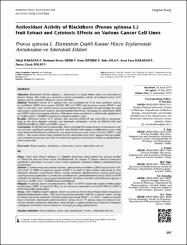| dc.contributor.author | Karakaş, Nihal | |
| dc.contributor.author | Okur, Mehmet Evren | |
| dc.contributor.author | Öztürk, İrem | |
| dc.contributor.author | Ayla, Şule | |
| dc.contributor.author | Karadağ, Ayşe Esra | |
| dc.contributor.author | Polat, Derya Çiçek | |
| dc.date.accessioned | 2019-12-26T12:34:26Z | |
| dc.date.available | 2019-12-26T12:34:26Z | |
| dc.date.issued | 2019 | en_US |
| dc.identifier.citation | Karakaş, N., Okur, M. E., Öztürk, İ., Ayla, Ş., Karadağ, A. E. ve Polat, D. Ç. (2019). Antioxidant activity of blackthorn (Prunus spinosa L.) fruit extract and cytotoxic effects on various cancer cell lines. Medeniyet Medical Journal, 34(3), 297-304. http://doi.org/10.5222/MMJ.2019.87864 | en_US |
| dc.identifier.issn | 2149-2042 | |
| dc.identifier.issn | 2149-4606 | |
| dc.identifier.uri | http://doi.org/10.5222/MMJ.2019.87864 | |
| dc.identifier.uri | https://hdl.handle.net/20.500.12511/4734 | |
| dc.description.abstract | Objective: Blackthorn (Prunus spinosa L. (Rosaceae) is a shrup whose fruits are consumed as food in Turkey. This study was aimed to evaluate antioxidant activity of methanol extract of P. spinosa and its cytotoxic effects on cancer cell lines. Method: Methanol extract of P. spinosa fruit was evaluated for its in vitro cytotoxic activity on multiform (GBM) brain cancer (LN229, U87 and T98G) and pancreas cancer (PANC-1 and AsPC-1) cell lines. Cell viability assays were performed by calculating the percentage of viable cells using a luminescence system, and spectrophotometrically. measuring its antioxidant ABTS and DPPH radical scavenging activities. Differences were considered as statistically significant at p*<0.001 and p**<0.0005 according to unpaired student t-test. Results: Methanol extract of P. spinosa fruit showed 2548±18 mg GAE/100 g corresponding to the total phenolic content, and moderate antioxidant activity (0.1896±0.1143 and 0.0729±0.0348) by ABTS• and DPPH• assays. Conclusion: To the best of our knowledge, after evaluating the results of brain and pancreas cancer cell lines, significant cytotoxic activities with 50-63% cell viability of GBM brain cancer cells were determined while no cytotoxicity was observed on pancreas cancer cell lines, PANC-1; and AsPC-1. The results of this study showed that the methanol extract of P. spinosa fruit has significant antioxidant capacity and leads to statistically significant decreased viability on glioblastoma brain cancer cells. | en_US |
| dc.description.abstract | Amaç: Çakal eriği (Prunus spinosa L.), Gülgiller (Rosaceae) familyasından bir ağaççık türüdür ve Türkiye’de meyvesi besin olarak tüketilmektedir. Bu çalışma P. spinosa metanol ekstresinin antioksidan aktivitesini ve kanser hücre hatları üzerindeki sitotoksik etkilerini değerlendirmeyi amaçlamıştır. Yöntem: P. spinosa meyvesi metanol ekstresi, glioblastoma multiform (GBM) beyin kanseri (LN229, U-87 ve T98G) ve pankreas kanseri (PANC-1 ve AsPC-1) hücre hatları kullanılarak in vitro sitotoksik aktivitesi araştırılmıştır. Hücre canlılığı deneyleri, biyolüminesans sistemi kullanılarak canlı hücrelerin yüzdesinin ve antioksidan aktivitelerinin, spektrofotometrik olarak ABTS ve DPPH radikalleri ile ölçülmesi yoluyla gerçekleştirilmiştir. İstatiksel anlamlılık eşleştirilmemiş öğrenci t testi ile p*<0.001 ve p**<0.0005 olarak belirlenmiştir. Bulgular: P. spinosa meyve metanol ekstresi, ABTS• ve DPPH• testlerinde toplam fenolik içeriğe karşılık gelen 2548±18 mg GAE/100 g ve orta düzeyde antioksidan aktivite (0,1896±0,1143 ve 0,0729±0,0348) göstermiştir. Sonuç: Elde ettiğimiz bilgiler ışığında, beyin ve pankreas kanseri hücre hatlarındaki sonuçlarının değerlendirilmesinden sonra, GBM beyin kanseri hücrelerinde %50-63 arasındaki hücre canlılığı ile önemli derecede sitotoksik aktivitesi belirlenmiş ancak PANC-1 ve AsPC-1 pankreas kanseri hücre hatlarında sitotoksisite gözlenmemiştir. Sonuç olarak, P. spinosa meyvesi metanol ekstresinin önemli antioksidan kapasiteye sahip olduğu ve glioblastoma beyin kanseri hücrelerinin canlılığında istatistiksel olarak anlamlı bir azalmaya yol açtığı gösterilmiştir. | en_US |
| dc.language.iso | eng | en_US |
| dc.publisher | Logos Medical Publishing | en_US |
| dc.rights | info:eu-repo/semantics/openAccess | en_US |
| dc.rights | Attribution-NonCommercial 4.0 International | * |
| dc.rights.uri | https://creativecommons.org/licenses/by-nc/4.0/ | * |
| dc.subject | Prunus Spinosa | en_US |
| dc.subject | Blackthorn | en_US |
| dc.subject | Cytotoxicity | en_US |
| dc.subject | Cancer | en_US |
| dc.subject | Antioxidant Activity | en_US |
| dc.subject | Prunus Spinosa | en_US |
| dc.subject | Çakal Eriği | en_US |
| dc.subject | Sitotoksisite | en_US |
| dc.subject | Kanser | en_US |
| dc.subject | Antioksidan Aktivite | en_US |
| dc.title | Antioxidant activity of blackthorn (Prunus spinosa L.) fruit extract and cytotoxic effects on various cancer cell lines | en_US |
| dc.title.alternative | Prunus spinosa l. Ekstresinin çeşitli kanser hücre soylarındaki antioksidan ve sitotoksik etkileri | en_US |
| dc.type | article | en_US |
| dc.relation.ispartof | Medeniyet Medical Journal | en_US |
| dc.department | İstanbul Medipol Üniversitesi, Tıp Fakültesi, Temel Tıp Bilimleri Bölümü, Tıbbi Biyoloji Ana Bilim Dalı | en_US |
| dc.department | İstanbul Medipol Üniversitesi, Rektörlük, Rejeneratif ve Restoratif Tıp Araştırmaları Merkezi (REMER) | en_US |
| dc.department | İstanbul Medipol Üniversitesi, Eczacılık Fakültesi, Eczacılık Meslek Bilimleri Bölümü, Farmakoloji Ana Bilim Dalı | en_US |
| dc.authorid | 0000-0002-9096-1512 | en_US |
| dc.authorid | 0000-0001-7706-6452 | en_US |
| dc.authorid | 0000-0003-3552-1554 | en_US |
| dc.authorid | 0000-0002-3412-0807 | en_US |
| dc.identifier.volume | 34 | en_US |
| dc.identifier.issue | 3 | en_US |
| dc.identifier.startpage | 297 | en_US |
| dc.identifier.endpage | 304 | en_US |
| dc.relation.publicationcategory | Makale - Uluslararası Hakemli Dergi - Kurum Öğretim Elemanı | en_US |
| dc.identifier.doi | 10.5222/MMJ.2019.87864 | en_US |
| dc.identifier.scopusquality | Q4 | en_US |



















